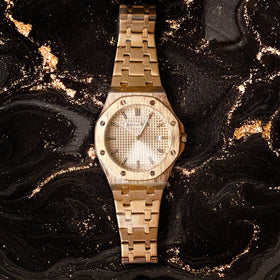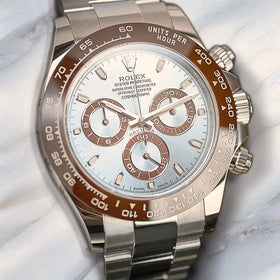We have provided below some frequently used terminologies in the watch industry. While we do our best to describe each model accurately, if you require further clarification on any specific term or concept, please don't hesitate to reach out to us with your question.
Analogue
An analogue watch indicates time using hands in a twelve-hour format and does not use a digital display. Typically, rotating pointers on a circular dial point to numbers and an array. The hour's hand movement is similar to the path of the sun across the sky.
Automatic
An automatic watch operates according to the same principles as a mechanical wind watch, with the addition of a weighted pendulum known as a "Rotor." This mechanical movement is wound automatically, and when a watch is in motion, the rotor spins around and automatically winds the watch. If an automatic watch stops or its power reserve ends, it should be manually wound more than 30 times.
Automatic Movement
A type of mechanical movement that winds itself automatically as you wear the watch. The movement uses a rotor that moves with the motion of your wrist to wind the mainspring.
Base Metal
Base metal refers to any non-precious metal such as steel or brass. They are more abundant in nature and thus cheaper than precious metals.
Battery
A battery consists of one or more cells, and the case of the battery can usually be found on the case back. The voltage in a quartz analogue watch is 1.5V, while in a digital watch, it is 3.0V.
Bezel
The bezel is a ring on the top side of the case located around the crystal. Its purpose is to measure time increments and can be classified as uni-directional or bi-directional. It helps control and start timing an event at any given time by aligning it at the beginning point. The bezel can be snapped or screwed on to the middle and can be rotated.
Bi-colour
Bi-colour is a specific kind of metal plating that finishes white and yellow juxtaposes, mostly located very close on the bracelet.
Bracelet
Each watch bracelet is a flexible metal band or metal strap attached to the case. It is typically made up of links that can be separated and removed to adjust the length of the bracelet. Sometimes, it is called integral if there is no apparent discontinuity, and the look of an attachment profile is similar to the first link.
Buckle
A buckle is a peculiar strap fastening that consists of a rim and a tongue, with one end attached to it and the other held by a catch in a secure but adjustable manner. It comes in a variety of shapes and sizes depending on the intended use and peculiar fashion. It is popular among watch manufacturers and can be made of various materials.
Carat
Carat refers to a unit of purity of gold alloys. Pure gold equals 24 carats, 18 carats stands for an alloy of which 75% is gold, 14 carats is the same alloy, but with less 58% of gold, and 37.5% of gold alloy equals 9 carats. Sometimes, it is called karat. The carat is divisible into one hundred points of two milligrams each.
Case
The case is a specific metal housing made up of three elements: middle, a bezel, and a back. It is mainly made of stainless steel, but sometimes gold, silver, and platinum can be used, although it increases the price. It is fixed with a strap.
Case Back
The case back is a cover that protects and cares for the movement of the watch. All necessary and required information can be found on it. Normally, it snaps back into place, and if it is a waterproof model, it will ensure that water cannot permeate the seal. Most case backs are made of stainless steel, except for those made of precious metal.
Chronograph
A watch with a stopwatch function that allows you to measure elapsed time. Chronographs can have one or more sub-dials for displaying elapsed seconds, minutes, and hours.
Complication
A feature on a watch that goes beyond basic timekeeping, such as a calendar, moon phase display, or chronograph.
Dial or Face
The watch face or dial is the plate that displays time and its functions using markers, discs, or windows. It comes in different shapes, materials, and decorations, often made of brass, silver, or gold. The face of a watch plays a crucial role in showcasing its inner workings, indicating the time, and giving it a unique identity. The layout of the mechanisms, wheels, complications, and other indications dictate the dial's appearance, including the position of hands, sub-dials, and apertures.
Dolphin Standard
Rotary watches marked with the Dolphin Standard offer an exclusive waterproof specification that allows wearers to participate in watersports all day without worrying about water damage. This standard ensures that the watch is suitable for activities like showering, yachting, diving, and other water sports, making it a revolutionary concept from Rotary. However, it's important to note that it's not suitable for deep-sea diving.
Duo Time or Travelcentric
A watch that features two movements, allowing the wearer to keep track of time in different time zones, is called a Duo Time or Travelcentric watch. This type of watch is particularly useful for travelers.
GMT
A complication that shows a second time zone on the watch's dial. This is useful for travelers who need to keep track of time in different parts of the world.
Hallmarks
Hallmarks are authorized stamps made on gold or silver watches, and they serve as one of the oldest and most useful forms of consumer protection.
Hands
The hands of a watch are the analog pointing devices that circle around the dial to indicate time and other special features. They come in different shapes and styles, such as Alpha, Sword, Breguet, Baton, Dauphine, Luminous, and Skeleton hands. These indicators made of thin, lightweight metal have been widely used in watches since the 18th century, and they often play a crucial role in the watch's aesthetic appeal.
Keeper
Special leather loops or a leather watch strap that keep the end of the strap in place where it can be fastened are called keepers.
Lug
Lugs are the arms of a watch case that hold the bracelet and are available in various designs and styles for consumers. They often have a double extension look and help the bracelet to be attached with removable spring bars.
Mechanical
A mechanical watch is powered by a mainspring housed within it. The mainspring needs to be wound by hand and then unwinds slowly to transmit power to a system of interconnecting gearwheels, called the gear train. This system is connected to the escapement mechanism consisting of a wheel and pallet fork that transmits impulses to the balance wheel. Another train moves the hands of the watch. Unlike modern quartz watches that function electronically, mechanical watches measure the passage of time. They are now more commonly worn for their unique aesthetic features and attributes, serving as jewelry or as a statement of one's style. As they are considered more traditional, they can be more expensive.
Mineral Glass
Mineral glass is essentially a form of glass used as a watch crystal. It is more scratch-resistant than acrylic but can still scratch, and it is difficult to polish after being scratched. It has superb reflective properties, strength, clarity, and is reasonably priced.
Movement
The inner mechanism of a watch is what makes it keep time and perform all its functions. Movements can be divided into quartz and mechanical groups, and the latter is available with mechanical or automatic winding devices. In other words, it refers to the assembled organs and mechanisms of any watch, namely the winding and hand-setting mechanisms, the mainspring, the gear, and the regulating organ (balance or spring).
Moonphase
A complication that shows the current phase of the moon. This is usually displayed as a small disk that rotates to show the position of the moon in its orbit.
Nickel Content
Not all watches are made of 100% nickel; only one or two layers are used underneath gold or rhodium plate. People are highly allergic to nickel, and copper has become a more popular alternative. The amount of nickel content in watches has been reduced since it was discovered to be an allergic substance. Sometimes it's referred to as nickel silver, a silver-white alloy of copper, nickel, and zinc developed in France in 1820.
Perpetual Calendar
A complication that automatically adjusts the date display to account for leap years and months with different numbers of days.
Power Cell
A power cell refers to another term for a battery that converts stored chemical energy. The lifespan of a battery varies from two to five years, depending on the type of watch and the amount of energy required for its functions. Watch power cells are usually silver-oxide or lithium.
Power Reserve
A feature that shows how much energy is left in the watch's mainspring or battery. This allows you to know when it's time to wind the watch or recharge it.
PVD Plating
PVD stands for Physical Vapor Deposition, which is an alternative to gold plating. It offers superior robustness and durability of color and composition. The PVD process ensures that a watch is placed in a high-pressure sealed chamber where gold creates a saturated atmosphere. As a result, stainless steel is completely penetrated by gold, and PVD plating does not discolor thanks to the total permeation of color throughout the metal.
Quartz Movement
A type of movement that uses a battery to power a quartz crystal. The crystal vibrates at a precise frequency and serves as the watch's timekeeping element.
Rotary Revelation
Swiss-made revelation watches for men and women offer a brand new style. The case rotates to show different dials, and two separate movements allow for displaying two time zones. It also offers a unique design with two different styles in only one watch.
Sapphire Glass
Sapphire glass is a type of synthetic crystal that is transparent, shatter-resistant, and scratch-resistant. It is produced by crystalizing oxide at high temperatures and ranks second in hardness after diamonds.
Sapphirite
Sapphirite glass is a mineral glass that has an extra layer for double durability, making it tough and hard.
Swiss Made
When a watch is assembled, adjusted, and tested in laboratories in Switzerland, it is considered Swiss made. Additionally, at least half of its parts and movements are originally made in Switzerland, while the case and bracelet may be manufactured elsewhere. The labeling of the watch must be strictly controlled to ensure it meets the Swiss made criteria.
Sterling Silver
Sterling silver is an alloy of silver that contains 92.5% silver and other metals, mostly copper, which provides strength while preserving the beauty of the precious metal.
Stainless Steel
Stainless steel is a steel alloy that contains a minimum of 10% chromium in its mass. It is a dense and extremely durable metal that is rust-resistant and does not require electroplating. The combination of elements used in stainless steel can vary, affecting its properties, and watchmakers use various grades of steel for different watch components.
Strap
A watch strap is a band that holds the watch to your wrist and can be made of various materials. Rotary watches are made of leather that is printed to imitate animal skin, but there are many designs, styles, and shapes of watch straps available to suit personal preferences and styles.
Spring Bar
Spring bars are metal pins used to attach watch bands or straps to watches. They come in different sizes, with an average size of 1.8mm, and are telescopic in design, slotting into the lugs of a watch case.
Screw Down Crown
A screw-down crown is an essential feature of any watch intended for swimming. It is threaded and screws into a matching tube in the watch case, compressing a gasket to seal the opening tightly and ensure water resistance. The crown is also more protected from accidental knocks and prevents moisture from entering the watch case.
Tachymeter
A scale on the watch's bezel or dial that allows you to measure speed based on the time it takes to cover a known distance.
Tourbillon
A mechanism that counteracts the effects of gravity on a watch's movement by continuously rotating it. Tourbillons are usually found in high-end watches and are considered a sign of fine craftsmanship
Water-resistant
Watches marked as water-resistant are designed to withstand exposure to water to a specific extent, but the degree of water resistance varies by watch. It is important to check the watch manual to determine its level of water resistance and to have it tested annually to ensure the seals and gaskets have not eroded with age.



